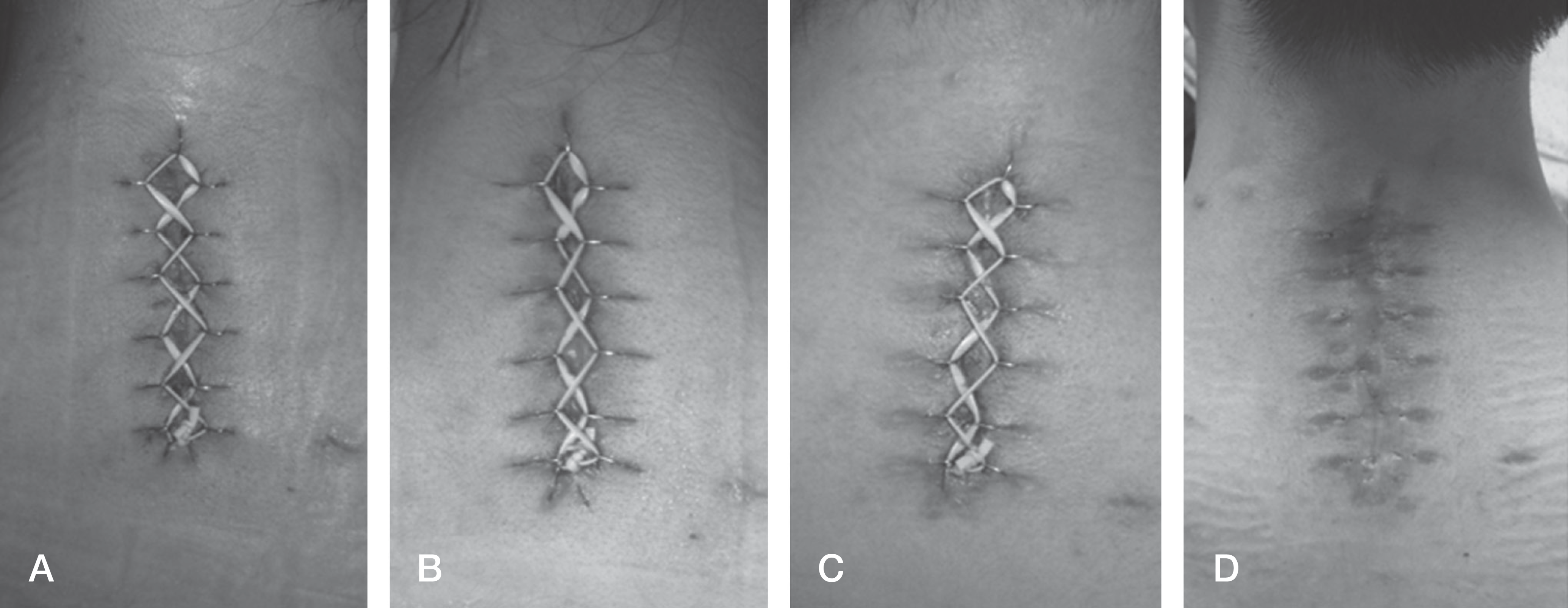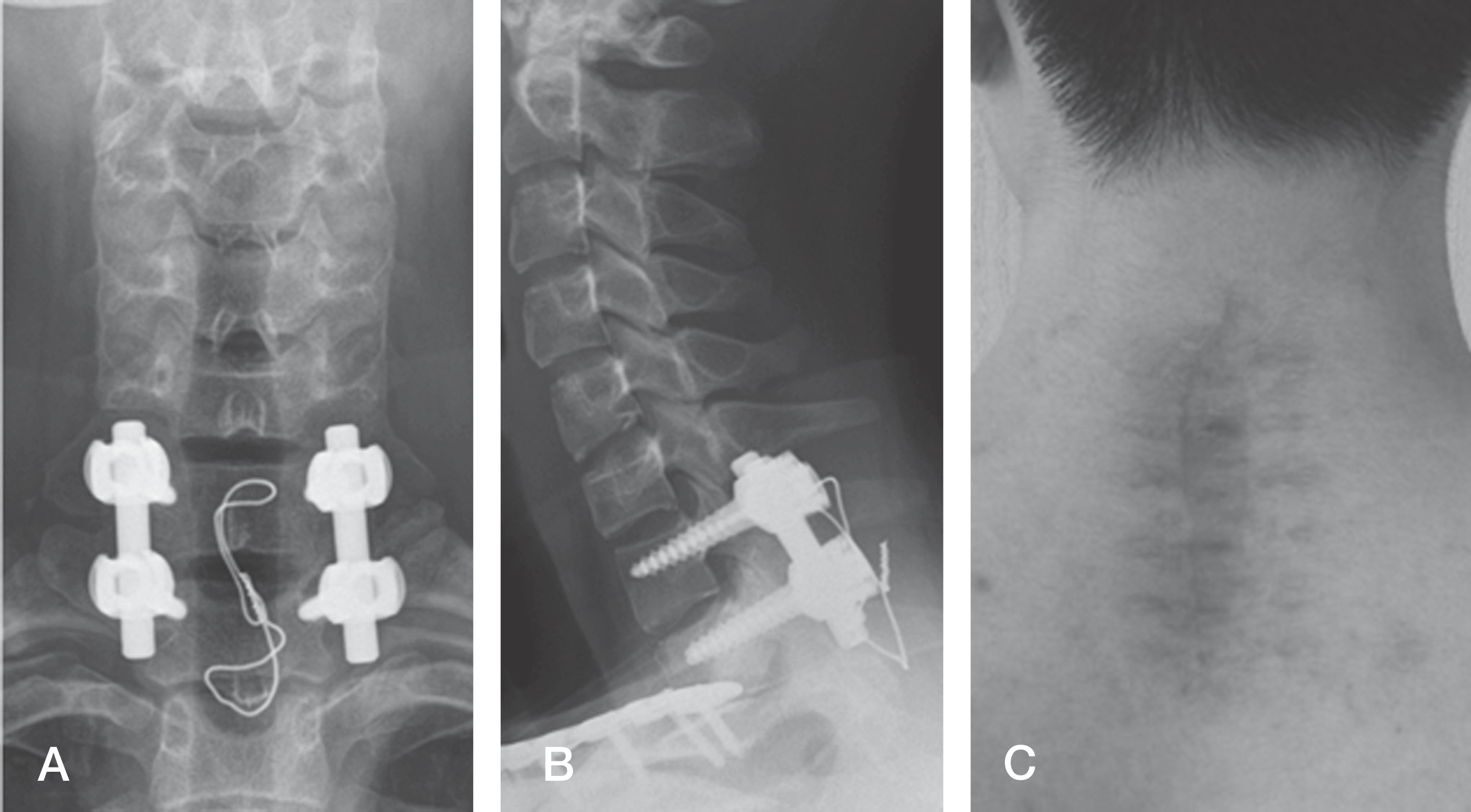Abstract
Objectives
To report the use of the shoelace technique for treatment of wound dehiscence caused by dural tears.
Summary of Literature Review
It is difficult to treat wound dehiscence caused by dural tears, as it can lead to infection, loss of soft tissue, and need for a long hospital stay.
Materials and Methods
An 18-year-old male who had been injured in a traffic accident was diagnosed with bilateral facet dislocation of C7-T1, with no neurologic deficit. Clear secretion appeared during the operation, but it disappeared after posterior fusion. The wound began to open about 3 weeks after the operation. We used the vessel loop shoelace technique to suture the wound,
REFERENCES
1. Luszczyk MJ, Blaisdell GY, Wiater BP, et al. Traumatic dural tears: what do we know and are they a problem? Spine J. 2014; 14:49–56.

2. Khan MH, Rihn J, Steele G, et al. Postoperative management protocol for incidental dural tears during degenerative lumbar spine surgery: a review of 3,183 consecutive degenerative lumbar cases. Spine (Phila Pa 1976). 2006; 31:2609–13.
3. Wang JC, Bohlman HH, Riew KD. Dural tears secondary to operations on the lumbar spine. Management and results after a two-year-minimum followup of eighty-eight patients. J Bone Joint Surg Am. 1998; 80:1728–32.

4. Fountas KN, Kapsalaki EZ, Johnston KW. Cerebrospinal fluid fistula secondary to dural tear in anterior cervical discectomy and fusion: case report. Spine (Phila Pa 1976). 2005; 30:E277–80.
5. Cammisa FP, Jr., Girardi FP, Sangani PK, Parvataneni HK, 6. Hannallah D, Lee J, Khan M, Donaldson WF, Kang JD. Cerebrospinal fluid leaks following cervical spine surgery. J Bone Joint Surg Am. 2008; 90:1101–5.
7. Asgari MM, Spinelli HM. The vessel loop shoelace technique for closure of fasciotomy wounds. Ann Plast Surg. 2000; 44:225–9.

8. Eid A, Elsoufy M. Shoelace wound closure for the management of fracture-related fasciotomy wounds. ISRN Orthop. 2012; 2012:528382.

9. Mahindra P, Bassi JL, Bassi D, et al. Shoe lace suture technique for management of lower limb diabetic amputations- a study of 24 cases. Pb Journal of Orthopaedics. 2011; 7:31–3.
10. Fowler JR, Kleiner MT, Das R, Gaughan JP, Rehman S. Assisted closure of fasciotomy wounds: A descriptive series and caution in patients with vascular injury. Bone Joint Res. 2012; 1:31–5.
Fig. 1.
(A-B) The initial anteroposterior and lateral view of plain radiographs. (C-E) Initial CT coronal and sagittal images. There was a bilateral facet dislocation of distractive flexion stage III between C7 and T1.

Fig. 2.
(A-B) The anteroposterior and lateral view of plain radiographs after closed reduction. (C-D) T2-weighted axial images and T2-weighted fat-suppressed sagittal images after closed reduction. MRI images shows compression fracture in T1, high signal intensity within the spinal cord between C7 and T1 and posterior ligament complex injury.

Fig. 3.
(A-B) Anteroposterior and lateral views of plain radiographs after posterior fusion with screw, rod, and wire. (C-F) Axial and sagittal CT images after operation.

Fig. 4.
(A) Clinical photo 3 days after operation, 2cc of bloody discharge drained out. (B-C) 10 days after operation, serosanguineous discharge was seen. (D) 22 days after operation, wound disruption was seen, as well as loss of soft tissue elasticity and viability. The size was about 2×8 cm. (E) Wound repair was done using the vessel loop shoelace technique.





 PDF
PDF ePub
ePub Citation
Citation Print
Print




 XML Download
XML Download